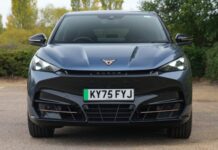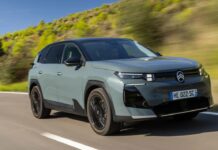Luxury car buyers are increasingly opting for smaller crossover SUVs over traditional sedans, and the shift is reshaping the automotive market. This trend isn’s solely about ride height; it represents a fundamental change in preferences driven by practicality, style, and a desire for versatility. Let’s explore the reasons behind this surge in popularity and what it means for the future of luxury vehicles.
Understanding the Landscape: What Is a Luxury SUV?
Before diving in, it’s helpful to clarify some terminology. What defines a “small” or “luxury” SUV can be surprisingly subjective. Governmental classifications, industry publications, and automakers themselves often use different criteria, making precise definitions challenging. For instance, the U.S. Department of Energy, which oversees the EPA, classifies the Lexus RX as a small SUV, while others don’t. The distinction between “compact” and “small” is similarly vague. However, one thing is clear: the number of luxury crossover SUVs available is rapidly increasing, and the market segment is significantly larger—nearly triple the size—than that of luxury sedans.
Current Market Leaders: Lexus Dominates
Analyzing recent sales data reveals a clear frontrunner: Lexus. In 2025, Lexus models, particularly the RX and NX, accounted for roughly one in six luxury crossover sales. This isn’t a result of a sudden surge; Lexus has consistently held a strong position. Even when factoring in the RZ and UX, Lexus maintains a considerable advantage. BMW and Mercedes-Benz remain significant players, while models like the Porsche Macan and Genesis GV70 are gaining traction. Notably, smaller crossovers like the Lexus NX, Acura ADX, and Mercedes-Benz GLA, along with the BMW X1, have experienced sales boosts. While it’s difficult to definitively link these sales increases to a decline in sedan purchases, the trend suggests a growing preference for smaller, more nimble SUVs.
Sales Winners and a Notable Loser
Over the past nine months, certain luxury crossovers have seen substantial sales growth. The Mercedes-Benz GLE (up 13.6%), GLC (up 15.8%), Volvo XC60 (up 18.4%), and Genesis GV70 (up a remarkable 25.7%) are among the top performers. Both the BMW X1 and Porsche Macan have also seen nearly 20% growth. The Mercedes-Benz GLA witnessed an impressive 84.65% sales increase. Conversely, the Tesla Model Y experienced a 23% sales decline.
The Appeal of Elevated Seating
One key factor driving the shift is the appeal of higher seating positions. A luxury crossover like the Genesis GV70, a popular example of a mid-range model, offers a seat about half a foot higher than a comparable sedan—like the Genesis G70. This extra height offers a blend of sedan-like agility and the visibility benefits of a larger SUV. Interestingly, many electric vehicles also adopt this mid-height crossover design, necessitated by the placement of batteries within the vehicle floor.
There are three key advantages to this position:
- It provides a good balance between sporty driving and comfortable visibility.
- Ingress and egress are easier than getting in and out of a low-slung sports sedan.
- The elevated position offers a commanding view of the road without feeling overwhelmingly large.
Compared to a full-size pickup truck, a GV70 sits significantly lower, but still feels more substantial than a standard sedan. This seating height also makes it easier to access and install car seats.
Luxury Features Beyond the Basics
The rise of the luxury crossover isn’t just about ride height. Buyers also appreciate the combination of upscale amenities and practicality. Models like the Genesis GV70 offer premium features such as heated and cooled Nappa leather seats, multi-hue LED accent lighting, and a Bang & Olufsen sound system. Notably, Genesis strikes a balance between physical and digital controls, offering dedicated interfaces for audio and climate—a welcome touch in an increasingly screen-dominated automotive landscape.
The Practicality of a Hatchback
Perhaps one of the most significant advantages of the crossover SUV is its cargo capacity, enabled by a hatchback design. The GV70, for instance, offers 28.9 cubic feet of cargo space behind the rear seats. While this is less than the 57.4 cubic feet offered by the larger Lexus TX, it’s comparable to the smaller RX and far more practical than the limited space found in traditional sedans. The ability to fold down the rear seats and create a larger cargo area enhances versatility.
Will Sedans Make a Comeback?
Despite the trend toward crossovers, the luxury sedan market hasn’t collapsed. Sales of models like the Toyota Camry, Honda Accord, and BMW 4, 5, and 7 Series remain steady. Notably, BMW is even experiencing a resurgence of interest in sedans and wagons among younger buyers who are growing tired of the uniformity of SUVs, as observed by BMW designer Oliver Heilmer.
Tastes shift over time, and unique styles can become desirable alternatives to the norm. However, manufacturers must be responsive to changing preferences and have the ability to quickly adapt existing platforms to meet evolving demand.
The Future of Luxury SUVs
Analyst Sam Fiorani of AutoForecast Solutions believes that sedans will eventually return to favor, but emphasizes the current dominance of crossovers: “Buyers want to sit higher and like the ability to throw stuff in the back. This is the current direction of the market.”
Ultimately, the rise of the compact luxury SUV reflects a broader shift toward practicality, versatility, and a desire for a commanding view of the road. The ease of cargo access provided by the hatchback design may solidify the SUV’s position as the new standard in luxury vehicles. The ability for manufacturers to respond quickly to changes in consumer preferences remains key as the automotive landscape continues to evolve.



























